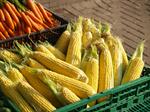Learn to plan a balanced diet

- Understand what quantities and combinations of food are appropriate for people to eat
- Understand how food handling and preparation affects the nutrient value of food
- Explore opportunities to apply a knowledge of human nutrition to improve your opportunities for food, health and associated industries.
There are eight lessons in this course, each requiring 12 hours work by the student. Emphasis is placed on understanding the body, the food we eat and how it affects, our mental and emotional health, as well as our physical state.
On completion of Human Nutrition I, this course builds on that foundation knowledge and really gets to the core of how nutrition impacts health and wellbeing.
Lesson Structure
There are 8 lessons in this course:
-
Cooking and it’s Effect on Food and Nutrition
-
The Nutritive Value of Food after Cooking
-
Meat and Poultry
-
Fish
-
Plant Foods – fruits, vegetables, cereals, pulses
-
How different methods of cooking and processing effects nutrients in food
-
Baking
-
Blanching
-
Braising
-
Grilling
-
Poaching and Boiling
-
Pressure Cooking
-
Roasting
-
Sautéing
-
Steaming
-
Preparing and Cooking Vegetables and nutrient loss management
-
The benefits of cooked food
-
Preserving the nutrition in food
-
Key points for preserving different vitamins
-
Set task
-
Assignment
-
Food Processing and Nutrition
-
Introduction
-
Canning and pasteurisation
-
Homogenisation and pasteurisation of milk
-
Milling and grain processing
-
Flours
-
How processing affects dietary carbohydrate and fiber
-
Effect of wet-heat treatments
-
Why do simple carbohydrates leech when wet-heat treated
-
Effect of food processing on starch and cellulose
-
Fiber in processed flour
-
Freezing
-
Dehydration
-
Effect of soils and fertilisers on food nutritive qualities
-
Food additives
-
Preservatives –salting, pickling, curing, smoking etc.
-
Food allergies
-
Flavouring agents
-
Additives to enhance colour and appearance
-
Sweetening agents
-
Emulsifying agents and stabilisers
-
Anti caking agents and humectants
-
Set task
-
Assignment
-
Recommended Daily Intakes of Nutrients
-
Recommended daily intake
-
Adequate intake
-
Tolerable Upper limits
-
Estimated average requirement
-
Macronutrient intakes
-
RDI for Energy and Protein
-
Fats
-
AI for Fluids or water
-
AI and TUL for dietary fibre
-
Requirements for vitamins
-
Requirements for Minerals
-
Set task
-
Assignment
-
Vitamins
-
Hypervitaminosis and hypovitaminosis
-
Fat soluble vitamins
-
Vitamin A –role, sources, deficiency, toxicity, etc.
-
Vitamin D –overview, sources, deficiency, toxicity, etc.
-
Vitamin E
-
Vitamin K
-
Fat soluble vitamins
-
Vitamin C
-
B group vitamins
-
Water soluble vitamins
-
Vitamins and the liver
-
Vitamins and the bowel
-
Vitamins, cancer and chronic diseases
-
Set task
-
Assignment
-
Minerals
-
Calcium – role of, deficiency, toxicity, calcium sources, etc
-
Iodine
-
Iron
-
Magnesium
-
Phosphorus
-
Potassium
-
Sodium
-
Other trace elements – chromium, manganese, molybdenum, selenium, Zinc
-
Set task
-
Assignment
-
Planning a Balanced Diet
-
Introduction
-
Menu Planning
-
Case Study – A day’s diet at a residential school
-
Plate waste
-
Assessing plate waste
-
Using a food pyramid
-
Steps for approaching diet planning
-
Set task
-
Assignment
-
Assessing Nutritional Status and Needs
-
Information
-
Infants and young children
-
Adolescents
-
Expectant mothers Post-partum and nursing mothers
-
Elderly people
-
Migrants
-
Vegetarian - Diet considerations: protein, amino acids, iron Vitamin B12, Vitamin D, etc.
-
Vegan diets and children
-
Weight change and snacking
-
Set task
-
Assignment
-
Timing Meals and Needs of Special Groups
-
Introduction
-
Diet formulation
-
Obesity
-
Coronary heart disease
-
Dietary risk factors
-
Blood cholesterol
-
Blood pressure
-
Dental cavities
-
Dietary fibre and bowel disease
-
Diet therapy
-
Low energy diet
-
Diabetes
-
Gastric Diets
-
Gluten free diets
-
Low salt, low sodium diets
-
Low fat diets
-
Diets to lower cholesterol
-
Set task
-
Assignment
Aims
-
Determine appropriate food preparation for different foods, in relation to food value for human health.
-
Explain the characteristics of food processing techniques and their implications for human health.
-
Recommend daily food intakes for people with differing nutritional needs.
-
Manage dietary intake of more significant vitamins including B and C complex vitamins for good health.
-
Manage dietary requirements of significant minerals including calcium & iron for good health.
-
Plan in detail, an appropriate seven day diet plan, for an "average" adult.
-
Determine dietary needs of different individuals.
-
Plan diets to achieve different, specific purposes.
-
Plan diets for specific needs for people at different stages of life.
What will this course teach you?
You will learn a wide variety of things, through a combination of reading, interacting with tutors, undertaking

research and practical tasks and watching videos. Here are just some of the things you will be doing:
- Determine the reasons for cooking food.
- Compare different methods of cooking food in terms of their effect on both health and nutrition.
- Explain the effects on nutrition of cooking different types of foods, for different periods of time, including: meat, fish, eggs, milk, plant foods.
- Explain how meat can be ensured to be fit for human consumption in a raw state, such as in sushi and in small goods.
- Distinguish between function, effects, and chemistry of different types of food additives, in food preparation, including: *Colours *Preservatives *Antioxidants *Vegetable gums *Flavourings *Thickeners *Anti caking agents *Bleaches *Emulsifiers *Humectants *Food acids *Mineral salts.
- Evaluate taste and nutritional effects of adding different specified flavourings to five different specified food dishes, including: *Salt *Sugar *Herbs *Wines.
- Explain, giving examples of specific foods, how "freshness" of different specified foods, impacts upon nutrient status of those foods.
- Explain how physical treatment of different specified foods (eg. cutting or crushing), may affect the food benefit of that food, including: *digestibility *keeping quality *nutrient status.
- Explain different heat treatments for food preservation; in terms of the process, function and affects; including: *drying *canning *bottling *pasteurisation.
- Explain freezing of food, in terms of the process, function and affects.
- Define examples of each of the following types of food additives: *Colours *Preservatives *Antioxidants *Vegetable gums *Flavourings *Thickeners *Anti caking agents *Bleaches *Emulsifiers *Humectants *Food acids *Mineral salts.
- Distinguish between function, effects, and chemistry of different types of food additives, in food preservation, including: *Colours *Preservatives *Antioxidants *Vegetable gums *Flavourings *Thickeners *Anti caking agents *Bleaches *Emulsifiers *Humectants *Food acids *Mineral salts.
- Analyse in a report, the effects of food additives found in different supermarket food items.
- Explain problems that may result from food additives including: *allergic reactions *hyperactivity in children.
- Explain different dehydration processes, in terms of the process, function and affects.
- Explain use of food processing techniques applied to different common foods with respect to food quality, storage life and cost.
- Compare the use of different food processing techniques on the same food, through in terms of the process, function and effect.
- Demonstrate five different food processing techniques, by independently preparing samples to a commercial standard.
- Compare recommended dietary intake information from different sources.
- Explain how food requirements vary, in terms of components and quality, at different ages, including: *babies *children *teenagers *young adults *elderly people.
- Recommend daily food intake requirements for a variety of different people who you are familiar with (e.g. elderly, young children, active young adults), listing components of a typical daily intake together with a profile of the person.
- List quality food sources of C complex vitamins in order of richest to poorest source.
- List quality food sources of B complex vitamins in order of richest to poorest source.
- Explain nutrient disorders associated with three different significant vitamin imbalances, including vitamin B complex, vitamin C, and one other vitamin.
- Evaluate different people you are familiar with, with respect to vitamin intake, lifestyle and health status, to determine if vitamin B & C needs are being satisfied.
- List food sources of calcium in order of richest to poorest source.
- List food sources of iron in order of richest to poorest source.
- Distinguish nutrient disorders associated with calcium and iron imbalances, in terms of diagnosis and significance.
- Evaluate different people you are familiar with, with respect to mineral intake, lifestyle and health status, to determine if mineral requirements including calcium and iron needs, are being met.
- Develop a questionnaire to analyse the dietary requirements of a person.
- Analyse the diet, lifestyle and general health of different individuals and compare the individuals analysed.
- Recommend aspects of diet which could be improved for individuals analysed.
- Explain discrepancies detected between different sources of dietary recommendations.
- Conduct a self assessment of dietary practices, determining in a summary report, areas of deficiency
WHY IS LEARNING ABOUT NUTRITION IMPORTANT?

Understand recommended Daily Intake. Shortened to RDI and also known as the recommended dietary allowance or RDA. RDI/RDA is the ideal amount of a particular nutrient that you should be ingesting daily. While they do vary from country to country, and are routinely revised and updating, the values presented here are those most consistently advised worldwide.
Understand Adequate Intake (shortened to AI). This is the value given when an RDI cannot be established or has not yet been established. Often this is used when scientific research is still lacking, or for special groups such as infants. It is the amount most accepted on the basis of current evidence to be adequate for the daily needs of the population it refers to.
Nutrition provided by foods is vital to good health. With so many fad diets and meal plans available to us, we really need to develop a deeper understanding of how dieting affects health overall.
Also with an increase incidence of food intolerances and allergies, get in know with what this means for you or your family members.
What we Eat can Depend on Where We Live
Populations exist in settlements around the world, across a vast range of geographical locations. Each location has its own unique environment that allows some foods to be widely available and others to be rare. Some of the factors that affect the types and quality of food available include climate, soil conditions, and accessibility.
Here are some examples of how these factors can have an affect on diet.
Climate – determines what plants flourish, and therefore what produce is readily available. For example, coconut palms may thrive in the heat and become a staple in a tropical diet, whereas in a cooler environment a coconut palm may not flourish. When you think of typical cuisine of a cooler place, such as England, you would rarely include fresh coconut.
Climate also affects the types of food required to maintain optimum health. For example, Eskimauan populations in cold, harsh climates of Alaska eat primarily meat, making protein and fat the main sources of energy. Eskimauan populations require a high proportion of fat in their diet to provide calories to survive the extreme weather conditions. Compare this to African populations in a hot climate, where their staple food is carbohydrate rich grains and relatively small amounts of fats and proteins in their diet.
Soil conditions – determines what nutrients are in the soil and what types of plants (if any) thrive. This can have a dramatic impact on what types of minerals are being absorbed from food. Minerals in the soil are absorbed by plants, then consumed by humans. If soils are rich in a variety of minerals they will provide greater nutrition to the consumers. If, however, a regions’ soils are depleted in certain minerals, people eating produce only grown in that region may become deficient in those minerals.
Specific plants prefer different types of soils, so a region may grow a particular type of crop more successfully than another. Also, some areas may be more fertile than others, hence producing crops more abundantly.
Accessibility – determines food availability. Some geographic locations allow greater access to a wider variety of food supplies than others. Remote locations are generally limited to local produce, whereas people in urban environment often have access to a wider range of food. When produce is being transported freshness becomes an issue, which then has an impact on the nutritional quality of the produce. Urban environments not only allow access to a variety of fresh produce, but also provide easier, and often more affordable, access to a full range of dried goods, spices, oils, condiments etc. An issue with these types of goods is that the processing required to preserve freshness may result in reduced nutritional content of the food. People living in urban environments often have a greater global influence in their diets, having access to international foods from supermarkets, specialty stores, and restaurants, allowing for great variety in their diet.
